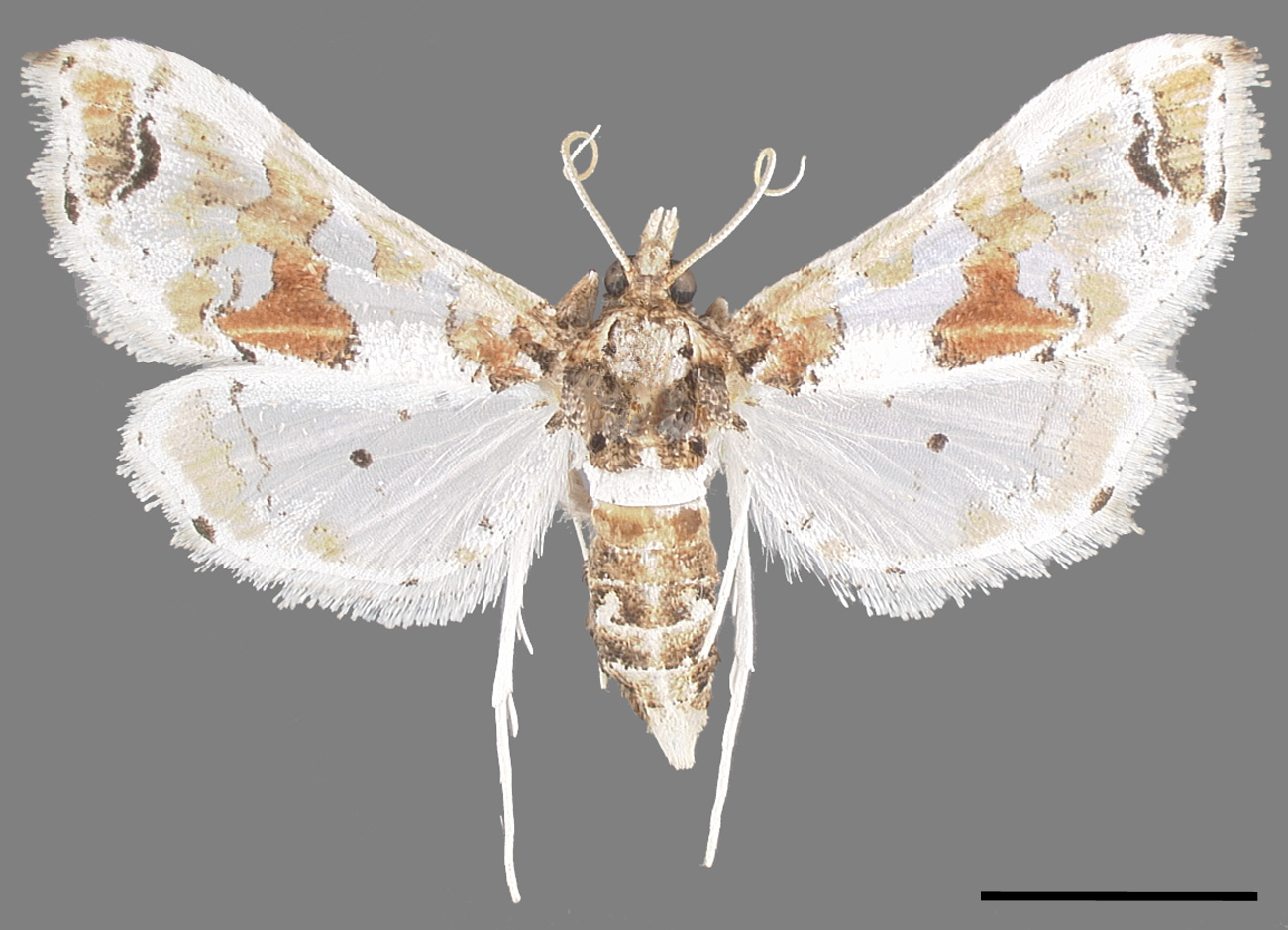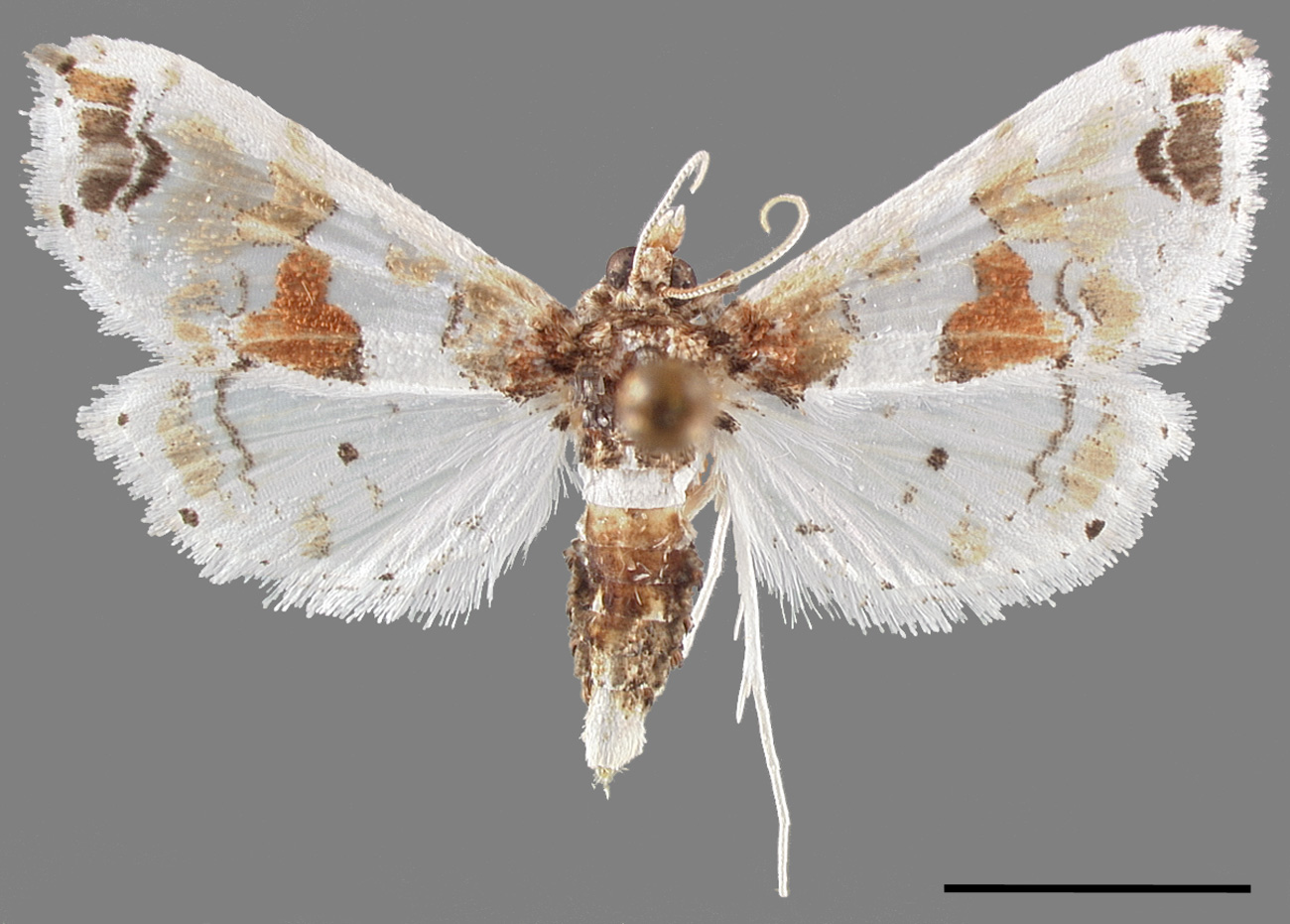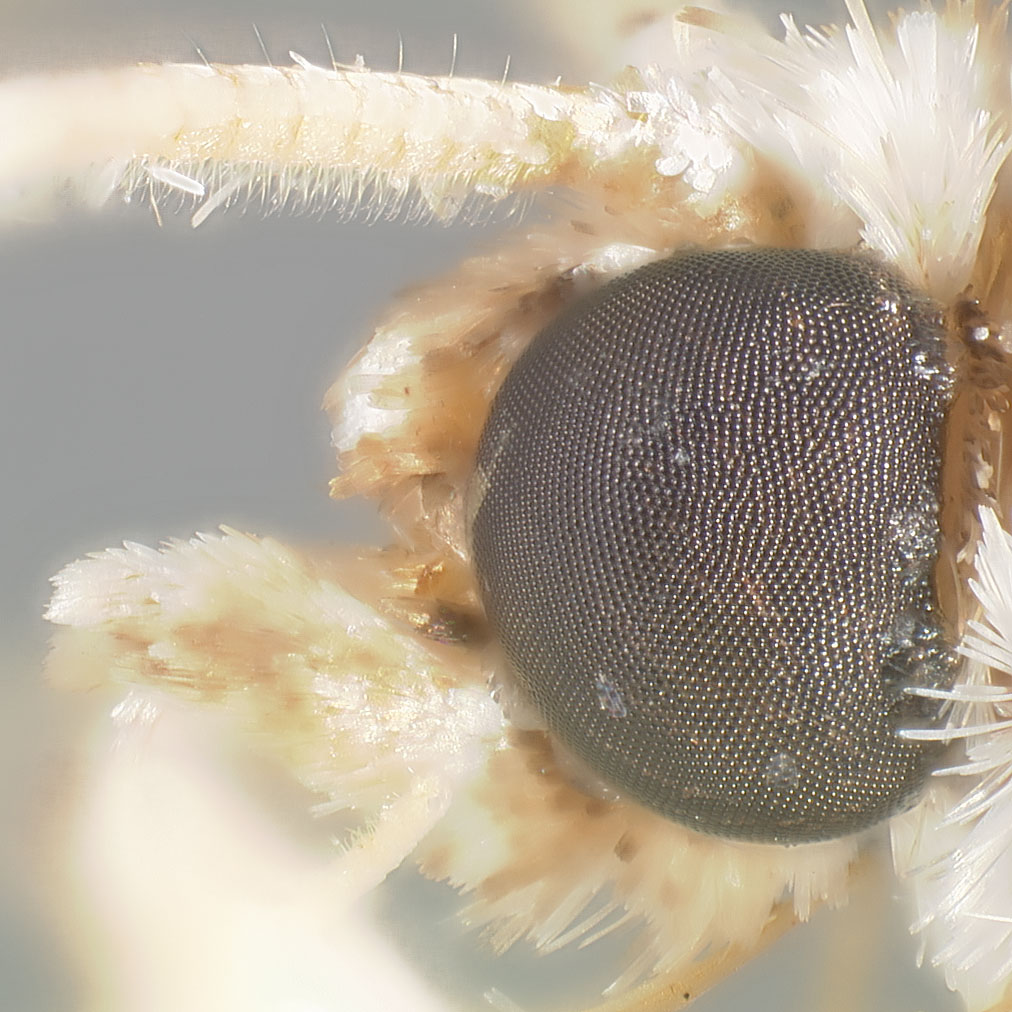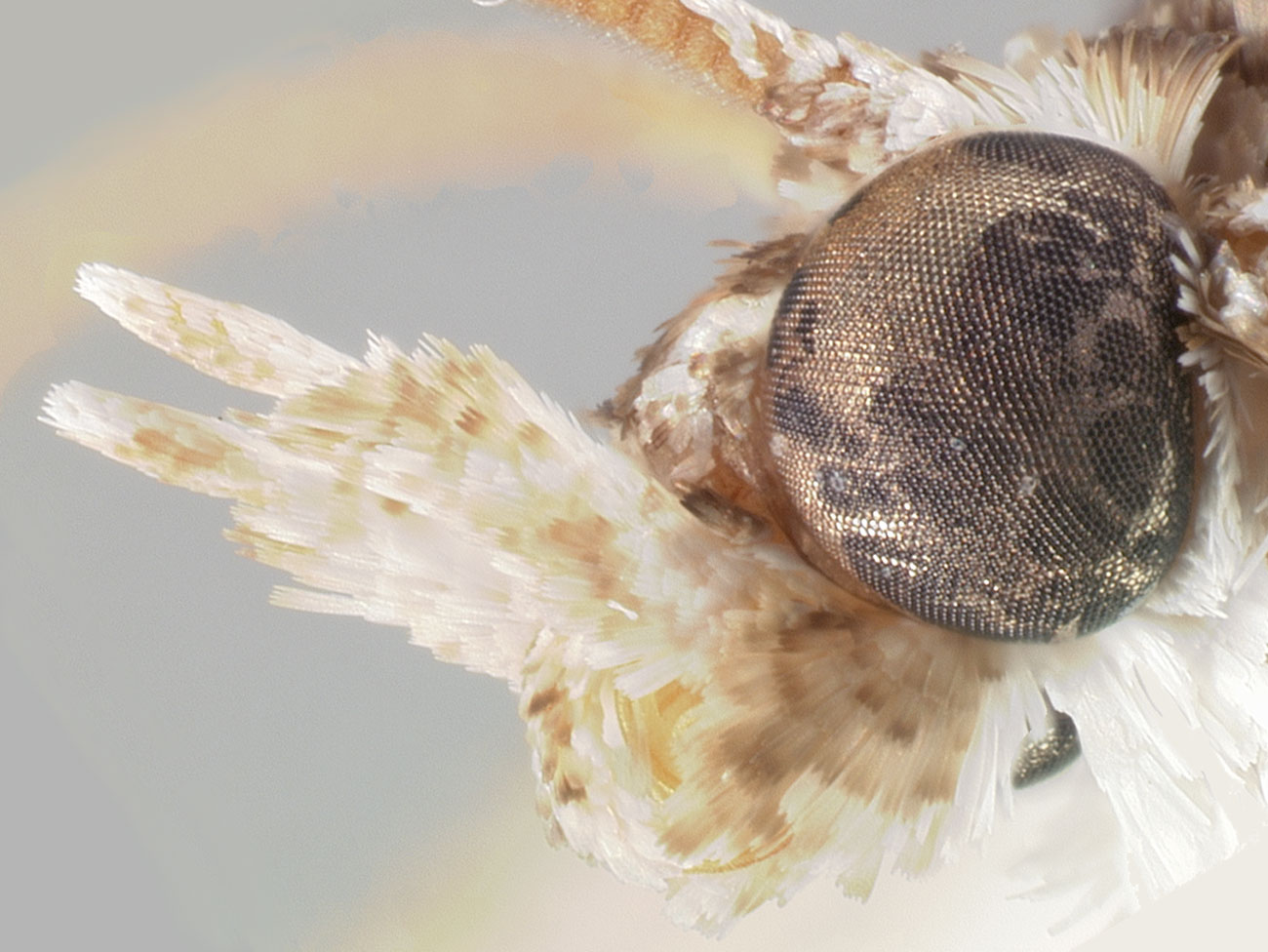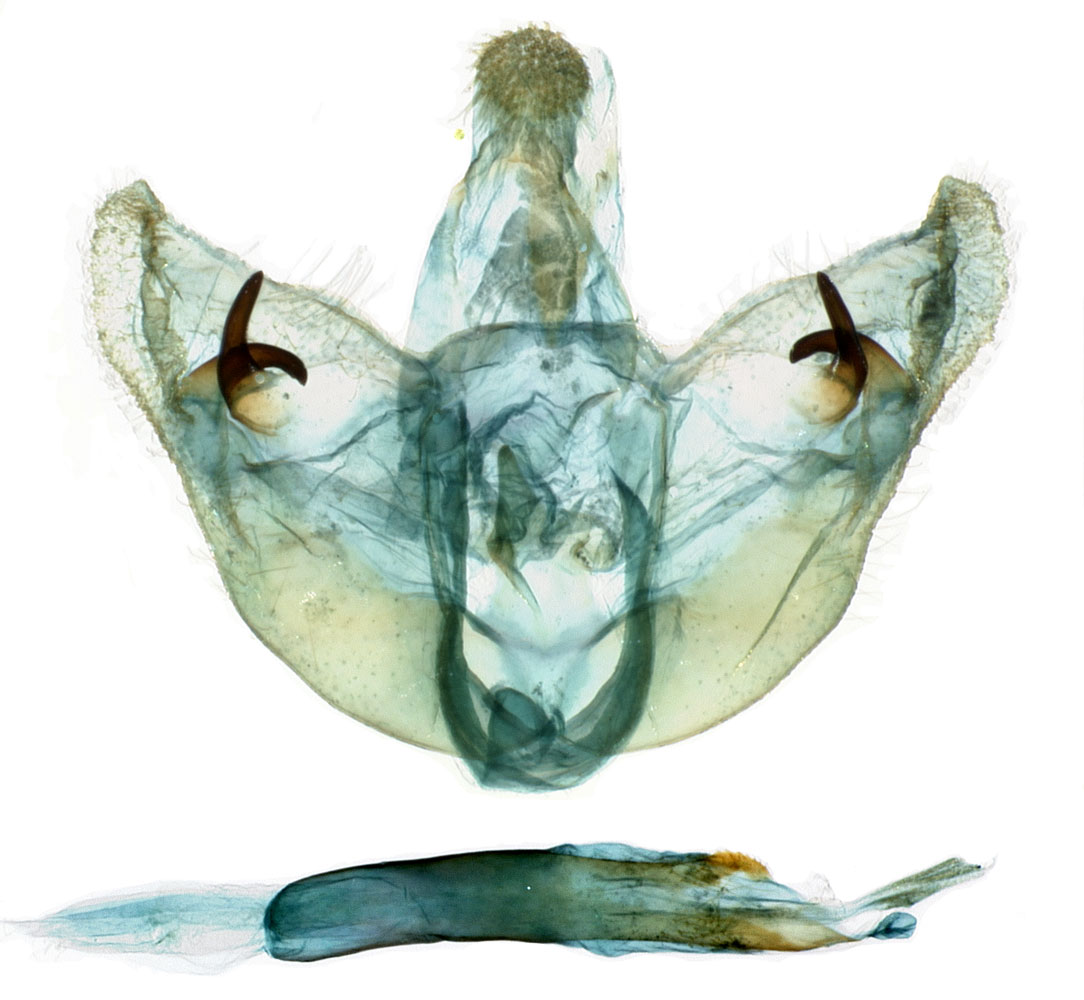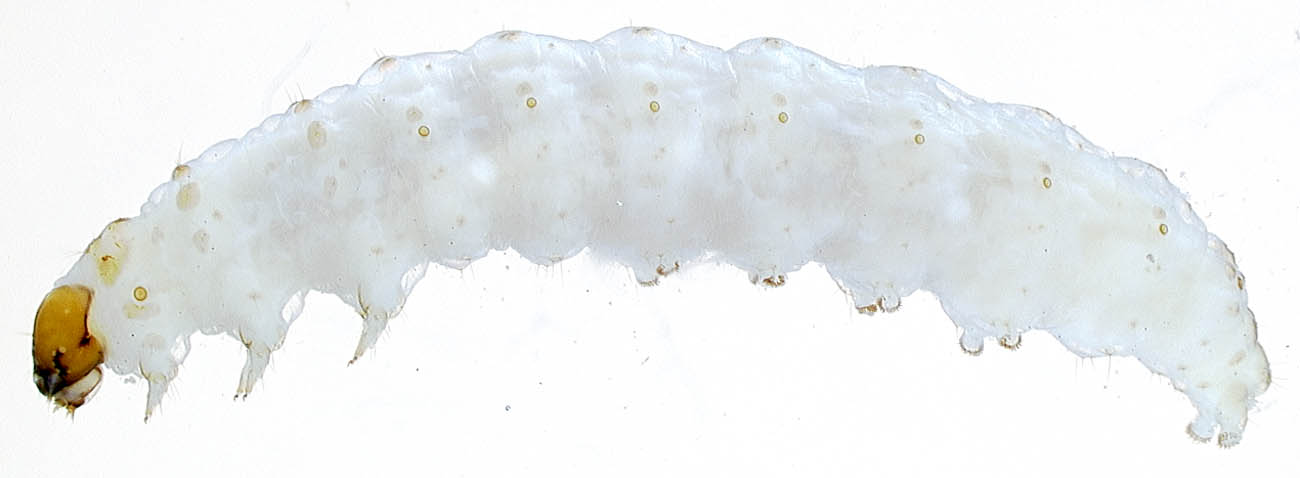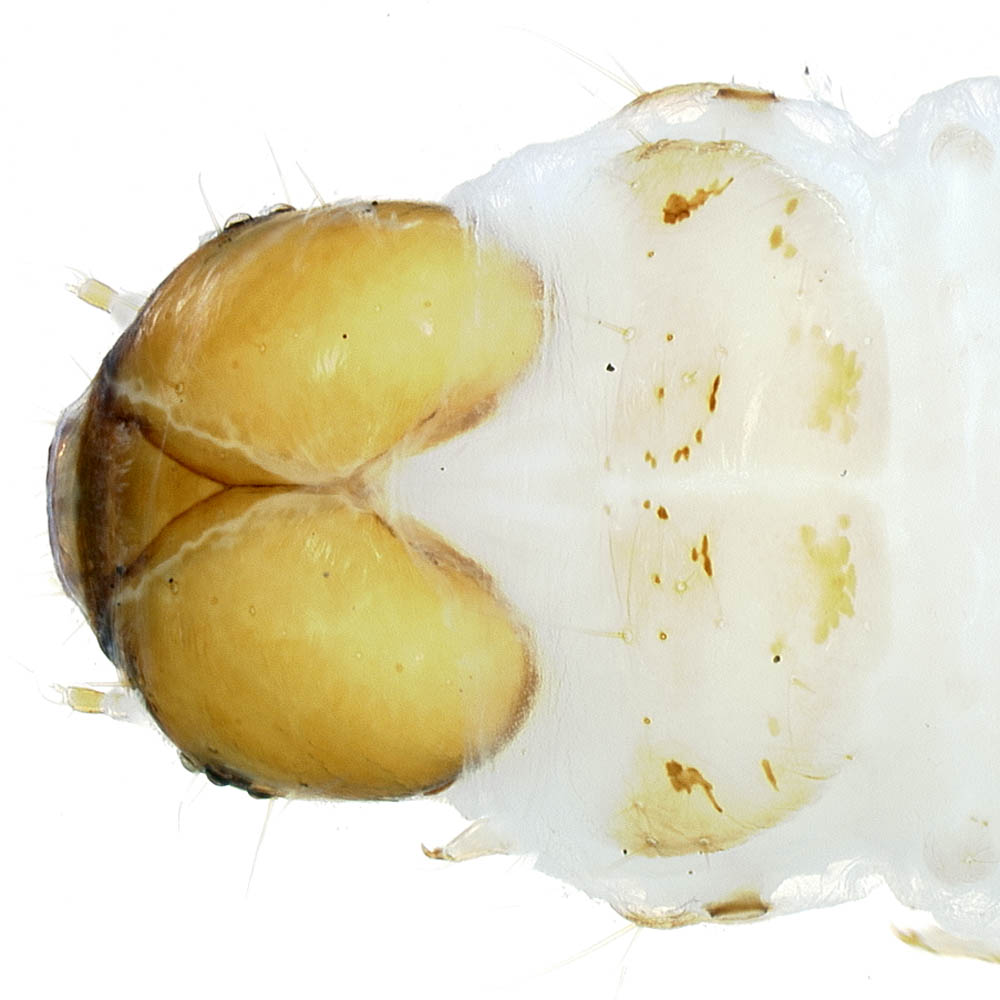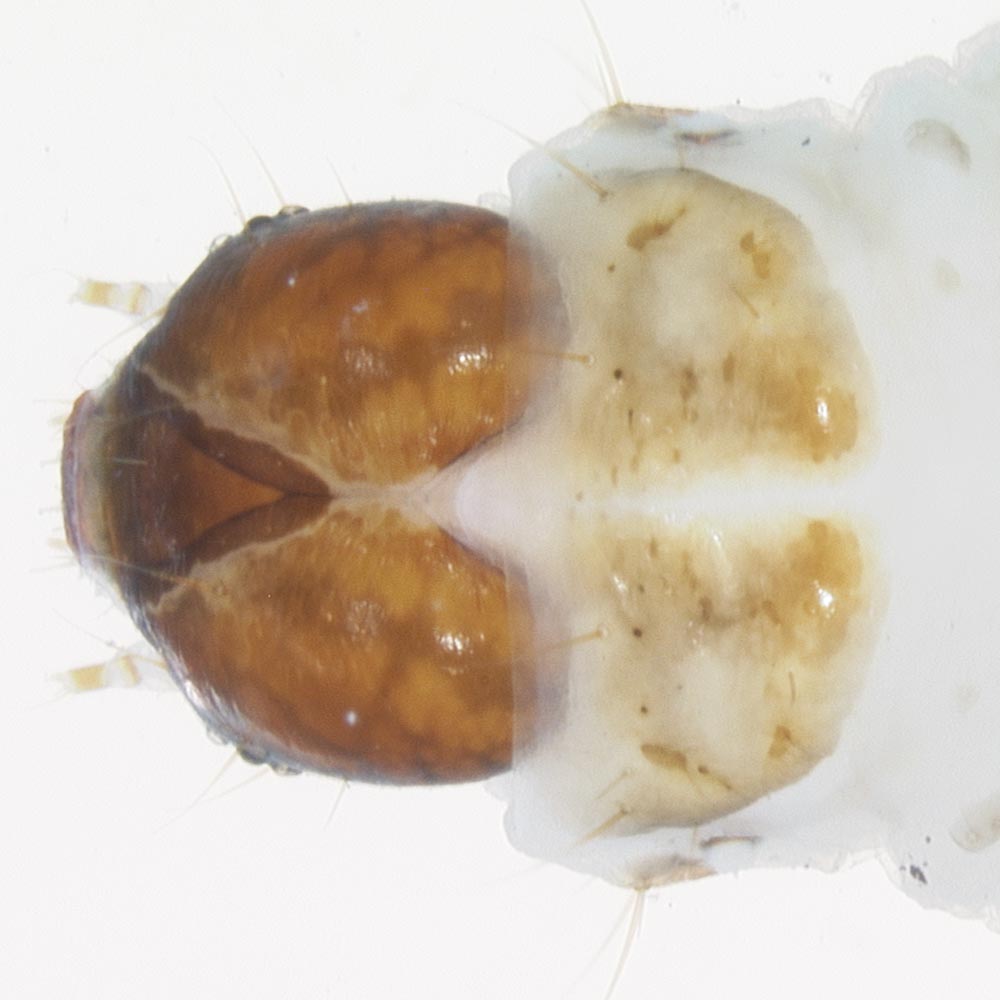Leucinodes orbonalis
|
Leucinodes orbonalis female habitus. Scale = 5 mm. |
|
Leucinodes orbonalis female habitus. Scale = 5 mm. |
|
Head of male Leucinodes orbonalis. |
|
Head of female Leucinodes orbonalis. |
|
Leucinodes orbonalis male genitalia. |
|
Leucinodes orbonalis female genitalia. |
|
Lateral habitus of Leucinodes orbonalis from Philippine Islands (FSCA). |
|
Larva of Leucinodes sp. from Ghana (USDA). |
|
Head and prothoracic shield of Leucinodes orbonalis from Philippine Islands (FSCA). |
|
Larva of Leucinodes sp. from Ghana (USDA). |
Name
Leucinodes orbonalis Guenée, 1854
Common name: Brinjal borer, Fruit and shoot borer (FSB), Eggplant borer
Original combination: Leucinodes orbonalis Guenée, 1854
Synonyms: none.
Alternative combinations: none.
Classification: Pyraloidea, Crambidae, Spilomelinae, Leucinodes group
Adult recognition
Forewing length: 8.5–12.0 mm, broad. The fronsFrons:
The front of the head, between the eyes.
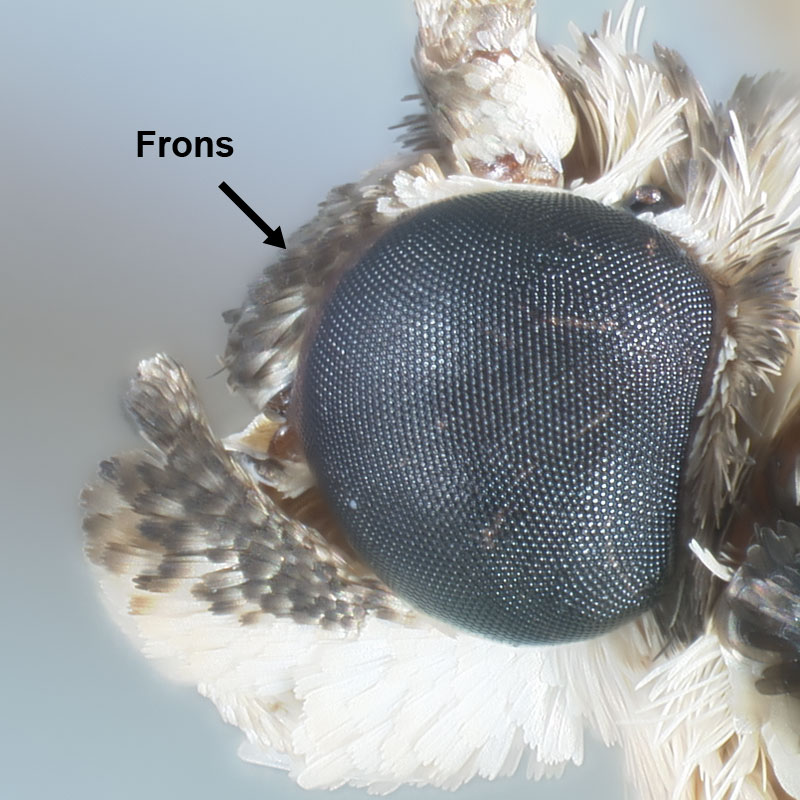 is more or less swollen into a rounded or bluntly conical projection. In the female, the apical palp segment is nearly as long as the second segment. In the male genitalia, the juxtaJuxta:
is more or less swollen into a rounded or bluntly conical projection. In the female, the apical palp segment is nearly as long as the second segment. In the male genitalia, the juxtaJuxta:
The sclerite ventral of the phallus, in the center of the male genitalic capsule.
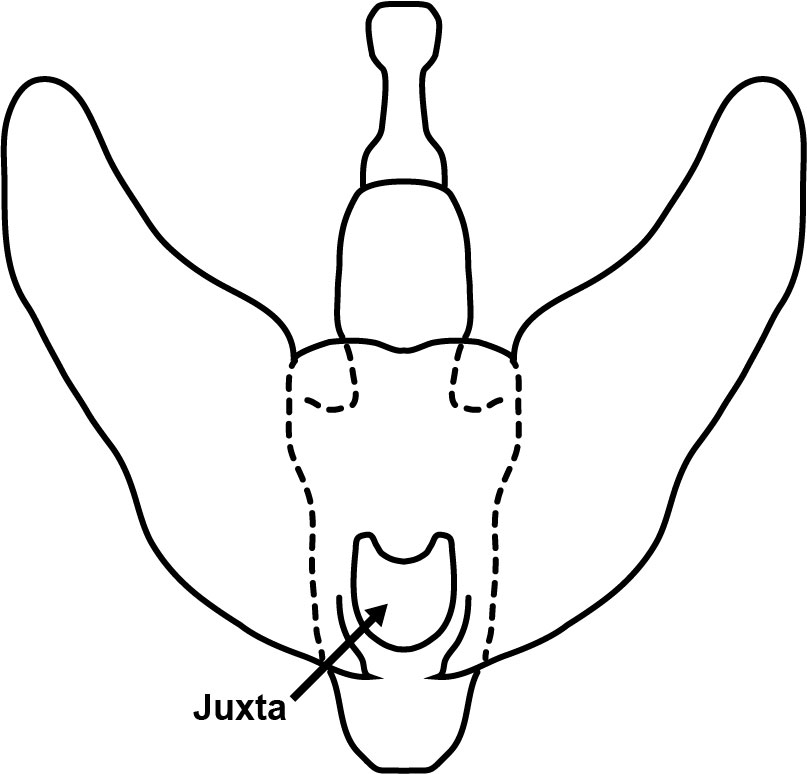 is broad and rectangular at the base and a projecting triangle at the apex. The two fibulae are stout, curved horns in the distal half of the valve. In the female genitalia, the corners of the 8th sternite are extended as ostial scleritesOstial sclerites:
is broad and rectangular at the base and a projecting triangle at the apex. The two fibulae are stout, curved horns in the distal half of the valve. In the female genitalia, the corners of the 8th sternite are extended as ostial scleritesOstial sclerites:
Sclerites associated with the ostium bursae.
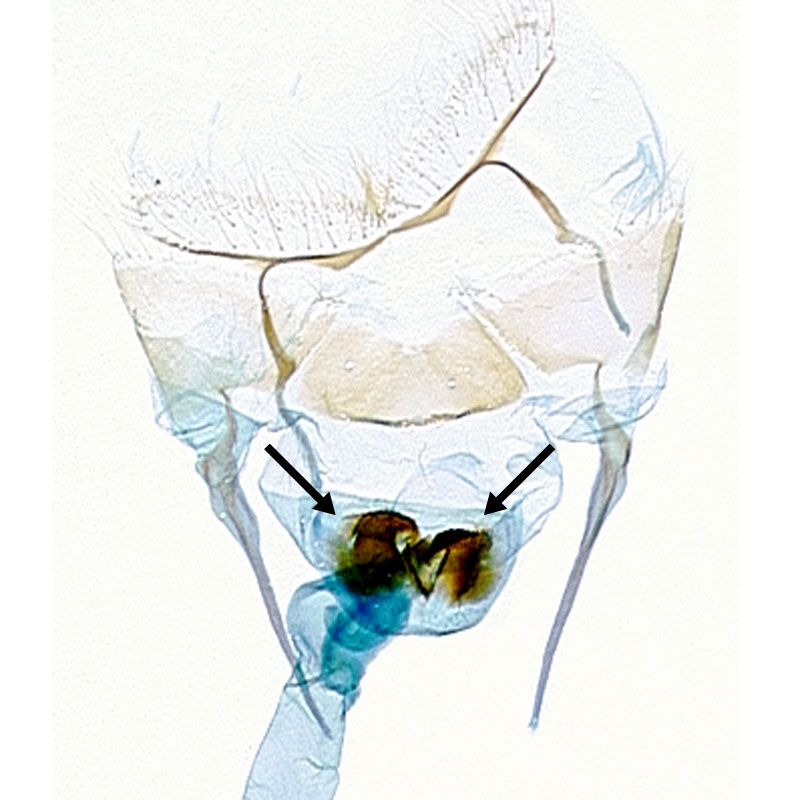 . The antrumAntrum:
. The antrumAntrum:
Posterior section of the ductus bursae, posterior of the colliculum.
 is not sclerotized and hardly thickened. The ductus bursaeDuctus bursae:
is not sclerotized and hardly thickened. The ductus bursaeDuctus bursae:
The usually narrow duct between the ostium and antrum and the corpus bursae.
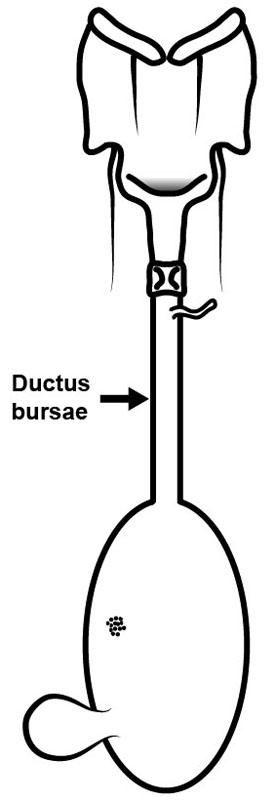 is as long as the round corpus bursaeCorpus bursae:
is as long as the round corpus bursaeCorpus bursae:
The enlarged, bulbous anterior end of the female genitalia.
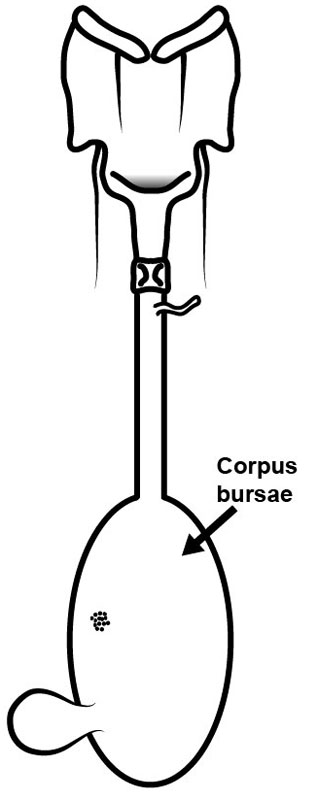 .
.
Immature stages
Larvae grow to 2 cm in length. The body is pink in life, the pinacula are pigmented pale brown, and each D1 pinaculumPinaculum:
In the larva, a raised, blister-like area that is often but not necessarily pigmented. They normally surround a seta, or if more than one seta, they are considered to be fused. Some taxa, especially internally boring larvae, may have extra pinacula without setae.
has a brown spot anterior of the setaSeta:
A larval hair (pl. setae).
. The T1 L group has two setae, and the A1 SV group has one. The A8 SD1 setaSeta:
A larval hair (pl. setae).
is anterior of the spiracleSpiracle:
Respiratory openings, mainly of interest for larval chaetotaxy. One pair on most segments.
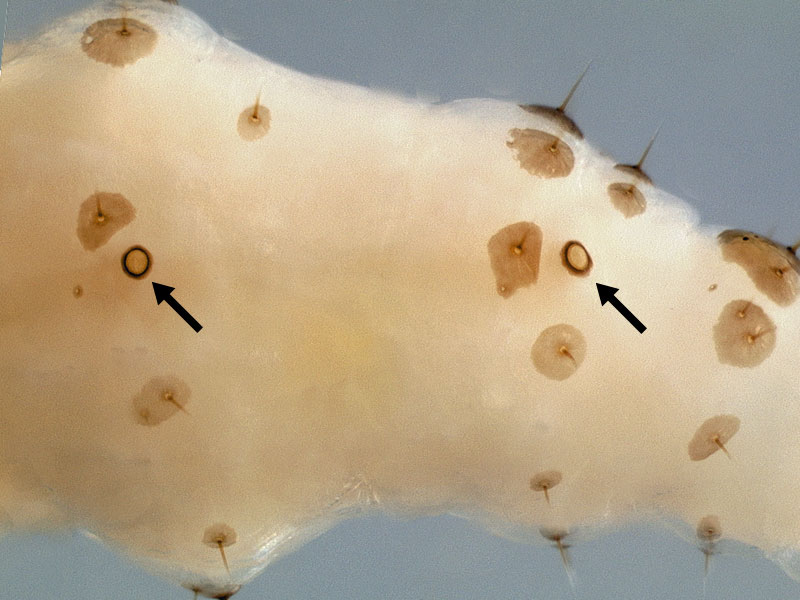 . Diagnostic characters that separate L. orbonalis larvae from related species in the complex have not been discovered.
. Diagnostic characters that separate L. orbonalis larvae from related species in the complex have not been discovered.
Similar species
The populations of “L. orbonalis” in Africa are not conspecific: they comprise at least three cryptic species. Externally nearly identical, they differ primarily in genitalic characters, such as the shape of the juxtaJuxta:
The sclerite ventral of the phallus, in the center of the male genitalic capsule.
 (which may be truncate or narrowly extended) and fibulae.
(which may be truncate or narrowly extended) and fibulae.
Neotropical genera that have a bulging fronsFrons:
The front of the head, between the eyes.
 are species in the Neotropical genera Euleucinodes Capps and Proleucinodes Capps. They are generally larger in body size, and the females do not have elongate palps. They have no reported economic importance.
are species in the Neotropical genera Euleucinodes Capps and Proleucinodes Capps. They are generally larger in body size, and the females do not have elongate palps. They have no reported economic importance.
Whittle and Ferguson (1987) comment on the use of the D1 spots to distinguish L. orbonalis from Neoleucinodes. Although these spots seem to be consistently present in Asian L. orbonalis, they may be absent in African populations and present in some Neoleucinodes species, such as N. torvis.
Behavior
Eggs are laid singly (rarely 2 or 3) on any part of the plant, preferably on growing parts. Larvae hatch in 3 to 6 days and bore into fruit under the calyx, or less often into shoots or mining leaves. Entry holes are small and packed with excreta, often hidden under the calyx. Larvae pass through 5 or 6 instars and are full-grown after one to three weeks. They prefer fruit or, secondarily, the soft growing parts of the plant. They emerge from the fruit through larger exit holes and spin a tough, brownish, leathery cocoon on the ground near the plant, sometimes 3 cm into the soil, or on other parts of the plant itself. Adults emerge after 7 to 12 days. The total life cycle lasts 23 to 35 days; in India, there can be 5 to 9 generations per year. Infested fruit rots, and other affected tissues (leaves, stems) wither.
Distribution
Aside from trade interceptions, the natural populations are restricted to South Asia, including China, Nepal, India, Japan, Pakistan, Sri Lanka, and much of Southeast Asia including Indonesia and the Philippines. In Africa, it is represented by at least one cryptic sibling species. In Europe, L. orbonalis is often intercepted with Solanum fruits imported from Asia.
Hosts
Preferred: Solanum melongena L. (eggplant, brinjal)
Secondary:
- Physalis minima L.
- P. peruviana L. (cape gooseberry)
- Solanum aculeatissimum Jacq. (Sodom apple)
- S. aethiopicum L. (Ethiopian nightshade)
- S. erianthum D. Don. (potatotree)
- S. anguivi Lam. (as S. indicum L.)
- S. integrifolium Poir.
- S. lycopersicum L. (tomato)
- S. macrocarpon L. (nightshade)
- S. melongena L. (eggplant, brinjal)
- S. mammosum L. (nipplefruit)
- S. nigrum L. (black nightshade)
- S. torvum Sw. (turkey berry)
- S. tuberosum L. (potato)
- S. viarum Dunal (tropical soda apple)
- S. xanthocarpum Schrad.
Comments
The preferred host is eggplant (S. melongena). Although L. orbonalis will feed on other hosts, such as tomatoes and potato shoots, its economic importance on these crops is lesser. For even less important cultivated plants, such as S. torvum, the frequency of damage may or may not be underreported. In any case, alternative hosts should nevertheless be considered as pathways for dispersal.
Literature
EPPO 2013EPPO 2013:
EPPO. 2013. Leucinodes orbonalis (Lepidoptera: Pyralidae,) Eggplant fruit borer. http://www.eppo.int/QUARANTINE/Alert_List/insects/leucinodes_orbonalis
Mahmood et al. 1987Mahmood et al. 1987:
Mahmood T, Alam Z, and Hussain I. 1987. Life history and morphology of brinjal fruit borer. Pakistan Journal of Agricultural Research 8: 298-300.
van der Gaag et al. 2005van der Gaag et al. 2005:
van der Gaag DJ, Stigter H, Lammers JW, and van der Straten M. 2005. Risk Analysis: Leucinodes orbonalis (Gueneacute;e). Landbouw, Natuur en Voedselkwaliteit, Plant Protection Service, Netherlands.
Whittle and Ferguson 1987Whittle and Ferguson 1987:
Whittle K and Ferguson DC. 1987. Eggplant fruit borer Leucinodes orbonalis Gueneacute;e. U.S. Department of Agriculture, APHIS, Pests Not Known to Occur in the United States or of Limited Distribution 85: 1-9.

